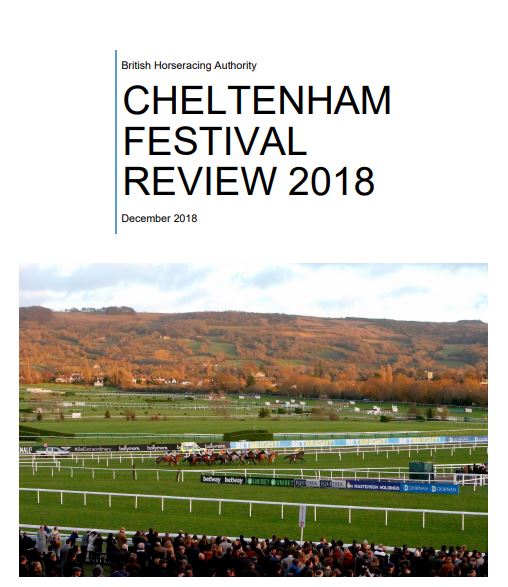
- 17 recommendations published to improve safety and welfare at Cheltenham and all Jump racecourses
- Cheltenham-specific recommendations include enhanced veterinary checks and targeted alterations to race conditions
- Wider recommendations include ambitious project to build a predictive risk model for all Jump racing to assist policy and welfare reforms in the future
- Review to act as springboard for wider focus on welfare and safety standards
The British Horseracing Authority (BHA) has today published its review of the Cheltenham Festival, following a rigorous process of data evaluation, consultation and review of video evidence, led by a dedicated review group and with input from external experts including the RSPCA and World Horse Welfare.
The 67-page report includes 17 recommendations which have the objective of reducing the risk of injuries occurring during the Festival and at other Cheltenham fixtures, and across Jump racing as a whole.
The full Cheltenham Review can be found here.
The Review’s 17 recommendations can be viewed here.
The central areas of focus for the review fell across six broad categories: the courses; the obstacles; participant factors; starts, safety factors and race tempo; programming and race conditions; and veterinary histories and protective measures. The detailed analysis covered all races run at the Festival from 2007 to 2018, including 5,451 runners and 308 fallers.
The evidence found that no single factor was definitively responsible for the equine fatalities at the 2018 Festival, and that non-track factors – such as veterinary, participant, and race condition factors – could potentially be of equal, or potentially greater, significance than track-related factors. The recommendations have been designed to reflect this.
 Brant Dunshea, Chief Regulatory Officer for the BHA, said:
Brant Dunshea, Chief Regulatory Officer for the BHA, said:
“The publication of this report represents the outcome of a substantial and significant project. The scale of research and evaluation carried out has allowed us to form a greater understanding of the variable factors that contribute to risk at the Festival, and to put in place tangible recommendations which we expect, collectively, to make racing at the Cheltenham Festival safer.
“Our thanks go to all involved, especially Cheltenham Racecourse and The Jockey Club who have always fully supported the need for a review and have actively engaged in the process.
“The publishing of this report does not by any means represent the end of our commitment to enhancing welfare standards, at Cheltenham racecourse and across all British racecourses.
“The report itself has found that non-track factors are likely to be contributing to risk at Cheltenham, and the same may be true across all of Jump racing. For this reason this project has become a springboard for wider research to better identify risk factors in Jump racing, above and beyond the continuous programme of innovation and improvement which has made the sport significantly safer in the last 20 years.”
Amongst the headline recommendations from the Review are:
- Pre-Race veterinary examinations will be increased to include all runners in all races at the Festival, with a view to identifying any risk factors that might make it necessary to prevent a horse from running in a race
- Reduction in ‘safety factor’ (maximum field size) in all 2-mile Chases run at the course from 24 to 20, with the race most likely to be affected by this being the Grand Annual Chase
- Race conditions of the Martin Pipe Conditional Jockeys’ Handicap Hurdle to be altered to remove all rider weight-claiming allowances, thereby incentivising connections to secure the services of the most experienced jockeys
- BHA to engage with participants to further identify factors that contribute to risk. This will include undertaking analysis of faller rates by trainer and jockey for Cheltenham and all Jump racing and engaging with those who have an incidence of fallers significantly higher than the average, alongside a wide range of other relevant participants
- The industry must support a major research project to develop a predictive model for identifying risk factors for all Jump racing, including horse history and performance, rider and training factors. Any risks arising from this significant work will be addressed and mitigated appropriately
An action plan for the implementation of the recommendations will now be developed by no later than February 2019, working with Cheltenham, Jockey Club Racecourses and others as appropriate.
Commentary in the aftermath of the 2018 Grand Annual, which saw three fatalities, suggested that the fatality rate had been adversely affected by the race being positioned at the end of Friday’s card. However, analysis of the County Hurdle and Grand Annual – comparing the faller rates of both races when they were placed as the last race compared to when situated elsewhere in the card – would suggest that the position of a race has little impact on the faller rate.
Faller and injury rates at Cheltenham – as with all racecourses – will continue to be monitored. Where data and evidence shows any further trends that may emerge the BHA will work with the racecourse in question to consider any action that can be taken to further improve safety rates. Through this process of continuous analysis, innovation and improvement the fatality rate in British Jump racing has fallen to 0.4% of runners.
 Nick Rust, Chief Executive of the BHA, said:
Nick Rust, Chief Executive of the BHA, said:
“British Racing must work together to reduce the risk of injuries occurring at The Festival and indeed Jump Racing as a whole. The recommendations of this review are designed to achieve this.
“I commend this review for the rigour and thoroughness of its approach. I also support the fact that its recommendations are intended to further raise the bar when it comes to welfare not only at Cheltenham, but across all of Jump racing.
“British racing has consistently and continuously improved its record on welfare outcomes over the last decade. However, Parliament has recently sent a clear message to our sport that we must raise our ambitions for welfare further. At the BHA, we share this view, and I am today calling on everyone in the sport to help us achieve even higher goals for welfare.
“The Cheltenham review helps demonstrate our sport’s commitment towards higher goals, but it is far from the end of our ambitions on this front. A cross-industry welfare Board is currently being formed, with the intention of delivering a new strategy for the sport. I hope that everyone involved in British racing will join us in working to further enhance our good track record, and ensuring the sport remains relevant, understood, accepted and embraced by the British public.”
Notes to editors
- The full Cheltenham Festival Review 2018 can be found here.
- The 17 Recommendations, which are included in the Report, can be viewed separately here.
- The Review Group comprised the following personnel:
- Brant Dunshea – BHA Chief Regulatory Officer (Executive Lead)
- David Sykes – BHA Director of Equine Health and Welfare
- Emma Marley – Head of BHA Racecourse Operations
- BHA Racecourse Operations Department
- BHA Racing Department
- BHA Veterinary Department
- Dr Sarah Rosanowski – PhD (Veterinary Epidemiology), PGDipVCS (Distinction), Bsc – Assistant Professor in Evidence-Based Veterinary Medicine
